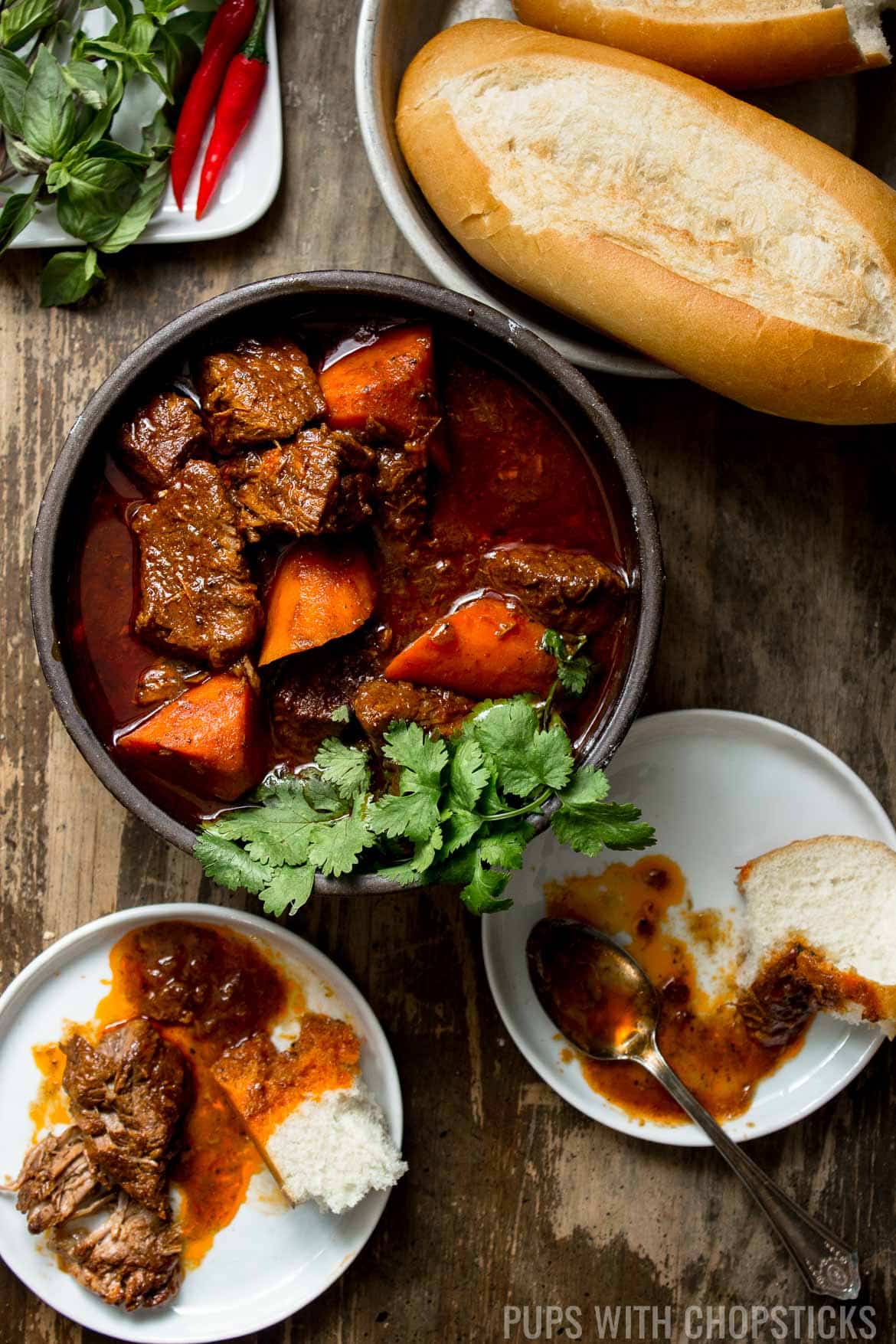
WHAT IS BO KHO?
Bo kho is a Vietnamese flavorful beef stew spiced with aromatics such as lemongrass, star anise, and cinnamon.
One of the biggest reasons why I love Bo Kho is because it is such a versatile dish. It can start out as a stew and be eaten with a baguette or some rice, and if you're feeling bored of the stew it can be easily transformed into a beef noodle soup bowl, simply by adding some beef broth and a few additional splashes of fish sauce and then garnished with basil and lime.
This dish is actually not very different than your traditional beef stew. The main difference is the wonderful aromatics which add a lot of extra flavor. Instead of using traditional herbs like herb de Provence, thyme or rosemary - Bo Kho uses star anise, lemongrass, and cinnamon. So if you have never tried this, and love beef stew, I would highly suggest you try this!
INGREDIENTS AND SUBSTITUTIONS
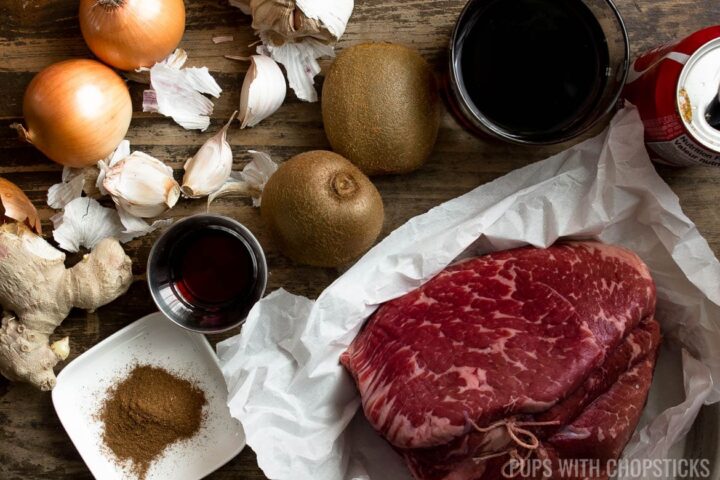
Beef - For this stew, I like using beef chuck because the meat doesn't get stringy and dry and gets really tender on its own without any tenderizer. Chuck is also known as blade roast. Oxtail is another favorite option as well but it takes a bit longer to cook. See below on ideas of the different types of beef you can use for this stew.
Kiwi - I use kiwi as a natural meat tenderizer for this stew. If I use chuck or oxtail, I generally will skip putting in the kiwi if I don't have it because those cuts of meat get tender naturally, the longer you cook it.
Cola - I use cola as another tenderizer as well. Cola gives the marinade a bit of sweetness as well which I lightly sweeten the stew in the end. Don't worry, you don't pour any of the cola marinade into the stew itself and it is discarded. It is also the main liquid of the marinade, so if you decide to omit it, add a bit of water in its place.
Ginger/Garlic/Onion - These 3 aromatics are a must in the marinade.
Chinese Five Spice Powder - This spice gives the meat marinade a nice spiced flavor
Fish Sauce - Fish sauce is the salt element of the marinade. You can substitute it with soy sauce, but I highly recommend sticking with fish sauce.
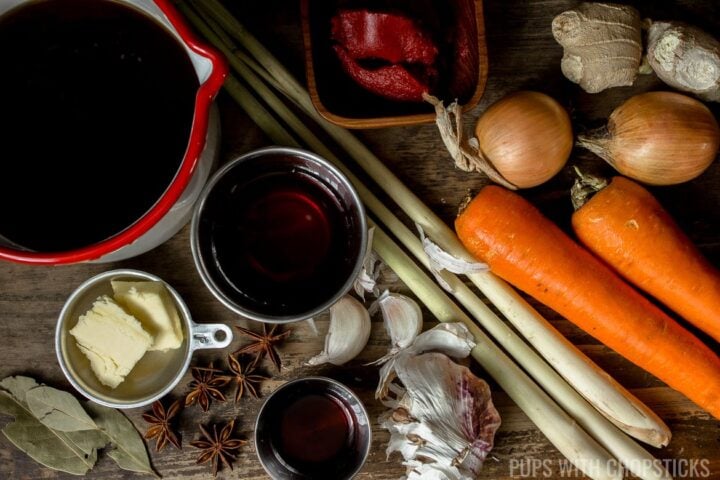
Lemongrass - I like to use fresh lemongrass stalks for this recipe, so I can easily find and remove them before serving it. If you are using fresh lemongrass, make sure you remove the outer layer and wash off any sand before smashing it to bruise it to release the flavor. You can find fresh lemongrass at your local Asian grocery store in the fridge. If you can't find fresh lemongrass, you can use frozen pre-ground lemongrass as well, but you won't be able to fish out the lemongrass at the end.
Broth - I like to use beef broth for this recipe. Try to use low sodium broth, so you can control how salty it is with fish sauce and salt in the end.
Tomato Paste - Tomato paste is the base flavor to this stew. You can put more to keep the stew thicker to eat with rice and baguettes, or you can put a little less with a bit more broth to thin out the stew to eat it with noodles.
Ginger/Garlic/ Onions - These 3 aromatics are a must in the stew. Do not omit it, it provides a lot of flavor to it.
Butter - I like to use a bit of butter to help the browning of the beef.
Shaoxing Cooking Wine - This cooking wine adds another layer of flavor to the stew. If you cannot find it, you can substitute it with dry sherry.
Cinnamon/Star Anise/Bay Leaves - These 3 spices are a must. They give the stew another layer of flavor that differentiates the standard stew to a Vietnamese beef stew.
Fish Sauce - This will give your stew a lot of flavor, as well as give its saltiness. I highly recommend you don't substitute this out.
WHAT CUTS OF BEEF TO USE

The type of beef cut you use in this Bo Kho is important if you want something tender with great mouth-feel without it being too dry or too stringy. Here are a few I turn to whenever I make Bo Kho, feel free to switch this up and experiment with it! Also keep in mind, that each type of beef's cooking time will also vary.
Beef Shank or Oxtail : I personally found the best cut of beef for this stew was beef shank or oxtail, partially because of all the connective tissues which eventually will melt into the stew giving it a silkier texture. It is very tender and has a slight chew without the stringiness. The downside to beef shank and oxtail is that it takes a lot longer to cook.
Chuck (aka top or bottom blade roast): This is my second favorite meat to use for the recipe. This is a fattier cut of meat which also has a great texture. Chuck is often labeled as a blade roast or a blade pot roast as well.
Boneless Beef Ribs : This one is more on the expensive side, but the marbling of fats combined with the connective tissues makes this a great cut of beef to use in Bo Kho. The final product when cooked is a very tender and buttery chunk of beef that practically melts in your mouth.
Beef brisket : I tend to stay away from it since the texture can be a bit stringy and since it is a tougher cut of meat, it takes a very long time to cook.
MARINATING (AND TENDERIZING) THE BEEF
I like to marinate meats before I cook them for additional flavor, but occasionally when I'm cooking tougher cuts of meat I like to use my marinade as a tenderizer as well. For Bo Kho, I like to marinate and tenderize the meat with a can of cola and a kiwi. The acids help break down the tissue (just make sure you don't over marinate this, 24 hours is usually more than enough time) and the sweetness from the marinade gives the stew just the right amount of sweetness.
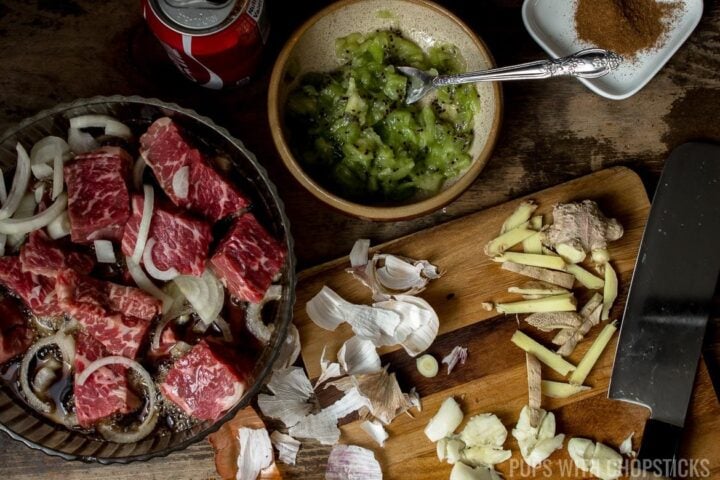
PREPARING THE REST OF THE INGREDIENTS
Make sure you discard the dry tips and the dried outer layer of the lemongrass, which sometimes have sandy bits stuck on it. Once you discard it, I give the lemongrass a good cleaning by rubbing it with my fingers under running water. Fresh lemongrass is a tough herb and I found that the best way to release its oils and flavor is to smash it once you have them cut into 2-3 inch chunks. I like to use a rolling pin but you can also use the back of your knife blade as well.


BROWNING YOUR BEEF
Browning beef is a pretty important step because it seals in the juices by locking in the juices with a crusty char but one of my main reasons for browning the meats are the char bits leftover in the pot. The little char bits are actually flavor! Once you start to add the liquids into the pot, the char bits will start to melt into the stew (with a bit of scraping action) giving it an extra layer of flavor.
Make sure when you are browning your beef, you are not overcrowding the pan. This will drop the temperature of the pan and your beef will end up steaming/boiling instead of browning. To get a nice brown crust on your beef, try not to touch it once you have it on the pan. This will give it a chance to form the char from the consistent heat on the meat surface. Check on it after 20-30 seconds and flip the beef.
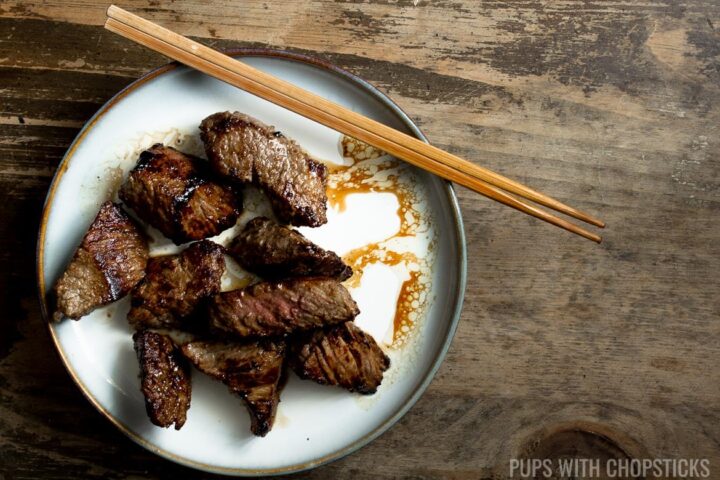
HOW TO SERVE BO KHO
One of the reasons I love making this dish is because it can be eaten in 2 different ways.
You can initially make it as a stew, and have it for dinner with some rice or dipped with a French/Vietnamese baguette and then make it to a soup for noodle bowl the next day simply by adding a cup of beef broth to it to thin it out and adding a bit more fish sauce to taste. That's a double-duty recipe right there!
Bo Kho (Vietnamese Beef Stew)
A Vietnamese beef stew has all the flavors of a traditional beef stew with additional aromatics from lemongrass and star anise to give it another dimension of flavor. It can be eaten as beef noodle soup with rice noodles or dipped in a french baguette! If you love beef stew, you definitely need to check out this Bo Kho recipe.
Cook ModePrevent your screen from going to sleep
PREP TIME: 30 mins
COOK TIME: 3 hrs
TOTAL TIME: 3 hrs 30 mins
COURSE: Main, Soup, Stew
CUISINE: Vietnamese
SERVINGS: 4 servings
CALORIES722 kcal
INGREDIENTS
Beef Marinade
▢1 kg beef (shank, oxtail, boneless rib, chunk or sirloin tip - see notes)
▢1 kiwi (smashed)
▢1 can of cola (355 ml, approximately 1 ½ cups)
▢2 inch ginger (cut roughly into strips)
▢2-3 garlic cloves (roughly chopped)
▢1 onion (cut into slices)
▢2 teaspoons five spice powder
▢1 teaspoon fish sauce
Bo Kho Stew Ingredients
▢2 inch ginger (sliced thickly)
▢4 cloves garlic (roughly chopped)
▢1-2 onions (sliced)
▢2 stalks fresh lemongrass
▢1 cinnamon stick (2 inch long)
▢3-4 star anise
▢3 bay leaves
▢¼ cup tomato paste (add an additional 2 tablespoons if you want a thicker stew)
▢2-3 tablespoons butter
▢3 tablespoons fish sauce (adjust to taste)
▢¼ cup shaoxing cooking wine (or dry sherry)
▢2-3 large carrots
▢4 cups low sodium beef broth (32oz)
(Optional) If You are Transforming it to a Noodle Soup
▢1-3 cup beef broth (add more if you like a thinner soup for noodles)
▢fish sauce (adjust to taste)
Garnishes
▢½ white onion (or any sweet onion, thinly sliced - don't skip this, it really adds a lot of flavor to the final dish)
▢fresh basil
▢lime wedges
▢crispy deep fried shallots
INSTRUCTIONS
Marinate the Beef
- Cut the beef into 1 ½ inch chunks and place it in large bowl
- Roughly chop the garlic and onions and place it in the bowl
- Slice the ginger and cut them into thick matchsticks and place it in the bowl
- Add the five spice, fish sauce and cola in the bowl
- Peel the kiwi and smash it with the fork, put the smashed kiwi in the bowl
- Mix everything well and marinate it overnight in the fridge. If you're pressed for time, marinate it for at least 4 hours in room temperature.
Preparation
- Remove the marinating beef from the fridge and drain the liquid.
- Discard the arromatics (the onions, garlic and ginger). Don't worry we use fresh arromatics for the stew.
- Let the beef sit in room temperature for an hour, this will help with the browning of the beef since the beef won't be as cold.
- Peel and slice an onion and set it a side
- Peel and roughly chop the garlic and set it a side
- Slice the ginger and set it a side
- Peel and chop the carrot into 2 inch chunks and set it aside
- Peel the dried outer layer of the lemongrass and cut off the dried tips and discard it. Wash the lemongrass to remove any sand. Cut the lemongrass into 2-3 inch chunks and smash it with a rolling pin or the blunt back of your knife to release the oils.
Putting It Together
- Place a large heavy bottom pot over the stove on medium heat and add a bit of oil with 1-2 tablespoons of butter
- When the pot is hot, add the beef in one at a time, careful not too crowd it too much. Brown the beef in batches. (The beef browns better if you touch it less, it gives it a chance to form a crust)
- Once all the beef has browned, add all the beef back in and add in the chopped onions, garlic, ginger, lemongrass, cinnamon stick and star anise and toast it with the meat for about 5 minutes
- Add in the tomato paste and mix everything well, cook for another 2-3 minutes
- Add in the cooking wine, beef broth and bay leaves and gently scrape the bottom of the pan if there are brown bits stuck to the bottom (this is flavor).
- Bring it to a boil. Once it has started boiling, reduce the heat to low and put a lid on it. Set a timer for 2 ½ hours. (If you are using oxtail or beef shank, you will need to cook it a lot longer, by approximately 1 hour more)
- Once 2 ½ hours has passed, check the beef for tenderness. If it is still tough continue to cook it for another 30 minutes. If the stew needs more liquid, add more beef broth or water.
- Once it is tender, add in the carrots and continue to cook it for another 30 minutes with the lid on until the carrots are soft
- Add the fish sauce and adjust it to your taste
- Fish out the lemongrass, star anise and bay leaves and serve with a baguette or with rice.
- (Optional) Making It Into A Beef Noodle Soup
Use the same steps in 'Putting It Together', but once the stew is done add in 1-3 cups of beef broth (depending on how thin you want the soup)
Add fish sauce to taste
Serve with noodles and thinly sliced sweet onions. Garnish with lime wedges and basil.
NOTES
If you use beef shank or oxtail, you will need to increase the cooking time, since they are tougher cuts of beef. Definitely worth it though.
If you use oxtail, you will get less meat if you use 1.5kg of oxtail since the majority of the weight will come from the bones.
This recipe and image sources are referred in website: Pupswithchopsticks.com. Thanks so much!
 Asian Recipes
Asian Recipes
No comments :
Speak Your Mind: